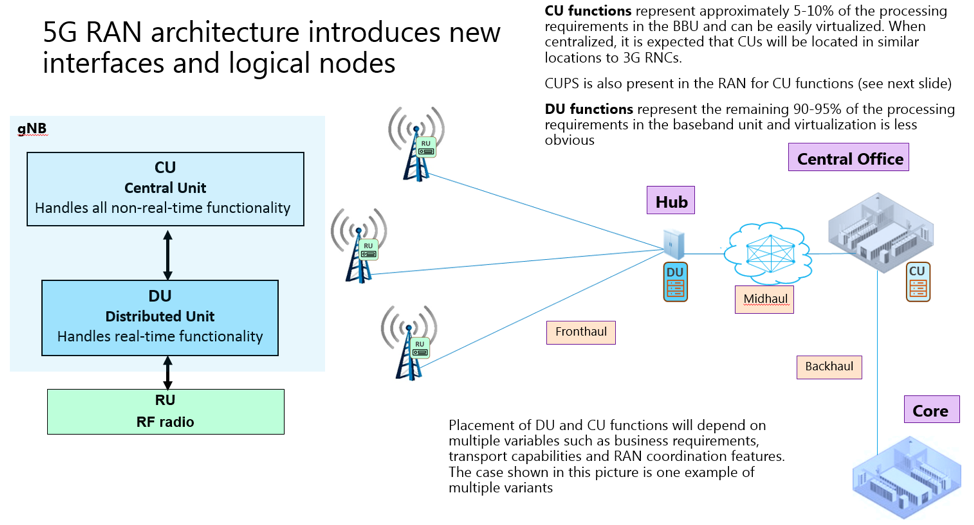The Evolution to 5G
Virtualization
In order to more efficiently and cost-effectively control the swaths of spectrum in 5G networks, MNOs will need to virtualize their infrastructure. Centralized Radio Access Networks (C-RANs) will be the precursor to Cloud Radio Access Networks (also C-RANs). Centralized Radio Access Networks form when MNOs move baseband processing units (BBUs) from the bases of cell sites to centralized BBU pool locations serving multiple sites. In the 5G architecture, the BBU functions are split into two parts: the CU (central unit), which handles the upper-layer, non-real-time functions, and the DU (distributed unit), which handles the lower-layer real-time functions. This allows MNOs to move the DU closer to the user to reduce latency (Figure 1).
Centralized RAN reduces the amount of equipment needed at each individual cell site and presents a host of other key advantages. Operators have options about where they put DUs in the network. If they move the DUs closer to the edge of the network, they obtain lower latency. If they centralize the DUs, they have more latency but can optimize the network more effectively by minimizing interference within a group of sites. 5G gives MNOs the option to support a much more diverse set of use cases that determine whether to use a centralized or distributed approach, trading off between performance and costs.

Figure 1: 5G architecture divides the baseband processing unit (BBU) into two parts.
In addition to saving on hardware costs, the C-RAN model can create significant savings in terms of power, cooling and site leasing costs. In Asia, the first region to successfully deploy C-RAN commercially, China Mobile has seen savings of 30 to 60 percent in total cost of ownership by deploying the C-RAN architecture.
Network Function Virtualization
A large part of the work to define 5G relates to a new architecture for the operators’ core networks. The primary goal of this architecture is to allow operators the ability to quickly and easily roll out new services. To accomplish this, the network architecture will take advantage of new networking paradigms such as network function virtualization (NFV) and software-defined networking (SDN). Operators will use these and advanced analytic tools for the core network in order to automatically optimize their networks under policy control.
 Cell Virtualization
Cell Virtualization
Cell virtualization extends the concept of virtualization beyond the core network and onto the airwaves. Inside buildings, cell virtualization will enable MNOs to manage multiple radio points within the footprint of a single cell. The result is the elimination of inter-cell interference while providing high capacity. C-RAN-enabled cell virtualization also gives operators the ability to re-use spectrum, enabling more dynamic and efficient use of this scarce and costly resource.
Network Slicing
5G networks are being architected to support diverse use cases by implementing a set of “network slices” that may serve different customers with different Quality of Experience (QoE) characteristics. These network slices are virtual instances running on a common infrastructure and may be sharing common resources such as computing, storage, and connectivity.



















